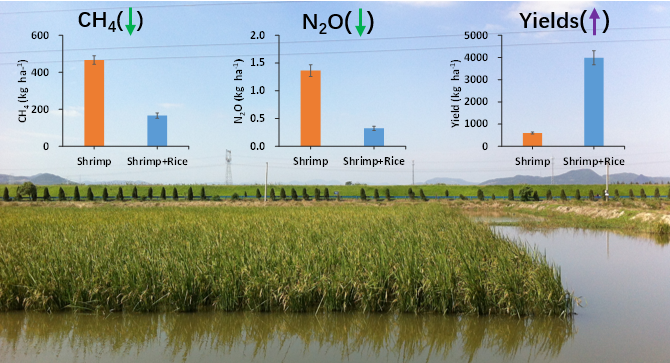In recent years, greenhouse gas emissions from aquaculture ponds has attracted increasing attention in academic community. Carbon emission reduction from aquaculture ponds will be a new focus in future international climate negotiations. China ranks first in the world in terms of pond farming scale and production, thus exploring the eco-technological way of stabilizing production and reducing emissions for the sustainable development is of great importance here. Aquaculture ponds are an important artificial aquatic system for global food fish production but also are a hot spot of greenhouse gas (GHG) emissions. The GHG mitigation strategy and the underlying mechanism for aquaculture ponds are still poorly understood.
Dr Dianxing Wu, Professor, College of Agriculture and Biotechnology, Zhejiang University, Adjunct Professor, Shanghai Institute for Advanced Study, Zhejiang University, together with collaborators published the article Higher food yields and lower greenhouse gas emissions from aquaculture ponds with high-stalk rice planted in Environmental Science & Technology. The work addressed the greenhouse gas emission reduction problem of aquaculture ponds, and adopted a specially bred high-stalk rice variety (Fishery Rice 1) to construct a new rice-fishery co-cropping model for aquaculture ponds proven to be conducive to emission reduction, promotion of nutrition and increase of food yields through years of field experiments. The authors also analyzed the emission reduction mechanism to provide a new technical roadmap for China's agricultural carbon emission reduction.

The authors conducted a 2-year field study to determine the effects of planting high-stalk rice (an artificially bred emergent plant for ponds) on GHG emissions from aquaculture ponds. The results showed that planting high-stalk rice reduced CH4 emission by 64.4% and N2O emission by 76.2% over 2 years. Planting high-stalk rice significantly increased the content of O2 in the sediment, thus prompting CH4 oxidation in the ponds. The reduction of N2O emission from ponds was attributed to the decreased inorganic nitrogen in the sediment induced by rice. Furthermore, high-stalk rice culture in the pond increased shrimp yields and gained rice yields, resulting in a significant reduction of yield-scaled global warming potential. The findings suggested that breeding appropriate emergent aquatic plants is a potential pathway to mitigate GHG emission from aquaculture ponds with more food yields and economic benefits.
The work demonstrated that the high-stalk rice had great application potential in the dominant aquaculture pond region to mitigate the GHG emission with more food yields and economic benefits. To access the full article please go to https://pubs.acs.org/doi/10.1021/acs.est.3c02667.

